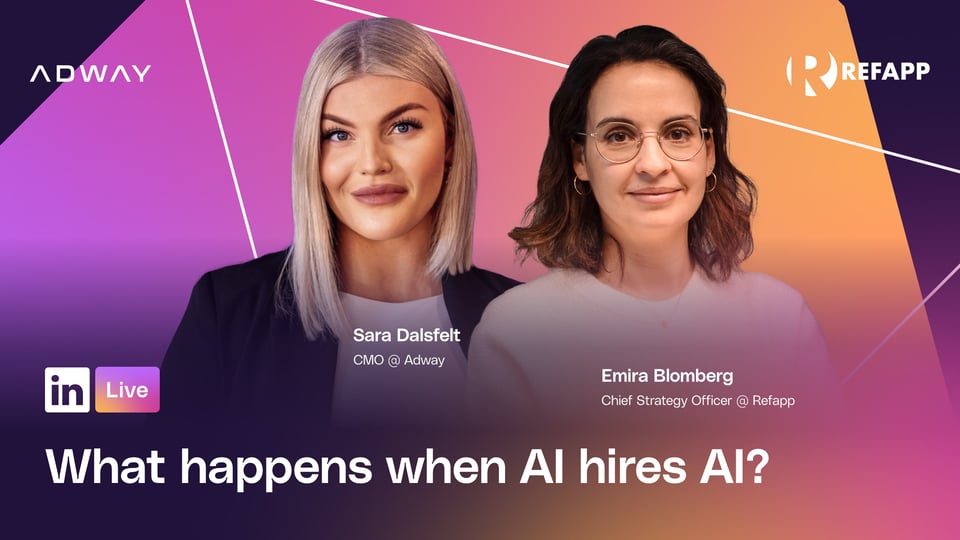AI-empowered candidates are not your problem…. your tech stack is!
That’s right. With both sides of the job market all out depending on AI for empowerment, efficiency and ease in the hiring process, we find ourselves asking exactly which responsibilities are being put on recruiters — from talent attraction, to reference checking, to using the right tech stack.
How do we turn the era of AI from gatekeeping to a gateway for both sides?
Emira Blomberg and the team at Refapp just won "Innovation Company of The Year" at the Recruitment Awards, and Emira sat down with Adway’s CMO Sara Dalsfelt to hash out all that and more to help you:
👉 Realise that AI-empowered candidates are not the problem - your tech stack is
👉 Unleash your full potential with the right TA Tech
👉 Navigate the EU AI compliance landscape
Keep reading to explore how, in the hands of forward-thinking recruiters, AI can forge a more inclusive, efficient, and candidate-centric hiring landscape!
You can also catch the full Adway Live episode right here:
Ensuring Authenticity, Accessibility & Fairness
It's crucial to remember we've been striving for a more candidate-friendly hiring process for years, so introducing barriers due to concerns about AI-empowered candidates would be a serious step backward.
To ensure our approach to AI, RecTech and recruitment continues to prioritize accessibility and fairness for our candidates, the focus should remain on leveraging technology to facilitate - not hinder - the advancements we’ve worked so hard to make!
It’s up to all of us to:
Understand the distinction between dishonesty and polishing responses.
Start by assessing the process steps or methods you already use for data collection and recruitment. For the end result (a good job fit and a candidate who contributes with value to the organisation), it doesn’t really matter if the application data is irrelevant or dishonest. That’s because certain data (i.e. cover letter details) can’t predict employee performance in the long run.
It’s crucial to take the “shine” and “show” out of the recruitment process by assessing performance predictors right off the bat. In doing so, any dishonest or over-polished data will become glaringly obvious, as the candidate fails to live up to their overhyped potential.
Recognise which behaviours you’re rewarding in the overall application process.
For instance, if perfect spelling or writing skills are the attributes your company uses to gauge a stellar candidate, it’s a no-brainer for an AI-empowered candidate to take advantage of AI-powered writing tools and assistants to help them win you over.
Acknowledge that these candidates finally have the leverage they need to level the playing field in the recruitment process, and recognise the added layer of pressure that puts on you as a TA professional to do your due diligence.
Determine who is more likely to fabricate data: The candidate or the reference.
Fabricating data or working with enhancement is nothing new, it just gets way more visibility in today’s AI-empowered TA landscape. For example, one study shows that 81% of candidates lie at least once during the interview process.
It’s up to recruiters to take a closer look at how their application process is designed. If you’re rewarding candidates for enhancing their data in the first place, you will continue to get what you give: inauthenticity.
Read more about empowering your reference checking process in this guide from Refapp.
Ensure the authenticity of reference data.
Are you weeding out instead of weeding in, and how are you then designing your application process to be simple and candidate friendly while also controlling toxic behaviours?
Recruiters have been previously trained not to “bother” candidates or their references, but in today’s digital age, ensuring the authenticity of your reference data becomes more important in the long run.
It’s time to shift the focus away from time-to-hire and instead redesign our processes to determine what is a good hire. We as recruiters can (and should) use AI to validate our own metrics and determine the quality of each hire we make.
How to Thrive in the Era of the TA Tech Amplified Recruiter
We’ve officially arrived! It is our time. And, of course it comes with a few challenges and nuances we’d love to help you navigate.
Determine what role technology plays in recruiting, and what rests solely on the recruiter.
In a nutshell: We need to learn how to co-exist with our technology and use it to make informed and human hiring decisions.
Start by asking yourself a few key questions:
- Which tools are you using to save time?
- Which tools are you using to enhance the candidate experience?
- What type of hire are you trying to make (campaign hire versus volume hire)?
These are all considerations that determine which data you actually need to make an informed hiring decision.
Focus recruitment processes on either excluding toxic behavior or identifying potential (or can it do both?).
It sure can do both!
The onus is on recruiters to refrain from placing too much emphasis on screening (such that it significantly slows down time-to-hire) while staying committed to protecting current employees from harmful behaviours that can disrupt and damage the workplace and its values.
Use automation to remove bottlenecks and prioritise human-centric interaction.
When we talk about empowering recruiters with AI tech, automation plays a crucial role in the process. Depending on the job category, each process needs to be designed differently. And, in order for that to work (where we have blue collar, white collar and sometimes big volume hires), we need to ensure each step is automated to stay efficient.
For instance, at least three references are recommended to identify patterns in a candidate's history. For organisations who receive thousands of applications per open position, conducting three reference checks per candidate is going to get someone deep in the weeds. We certainly can’t skip this process entirely, but what we can do is automate it to eliminate bottlenecks.
Automation in recruitment is about designing a process that supports both the recruiter and the candidate, saves time on both sides, and allows recruiters to prioritise their human time above all else.
To learn more, check out the Adway Guide to Smarter Automation.
Introduce 'quality of hire' as a metric before fully implementing AI tools.
In a perfect world, performance metrics will be fed back into hiring metrics in a continuous loop. Unfortunately, closing that loop is easier said than done, and often overlooked.
At some point in the near future, AI should enable this process and close the gap by feeding data back to the ATS, so we can start drawing conclusions around relevant data processes for each job category and the future performance of our hires.
Are they living up to their potential? AI will help us answer that question.
Question your reliance on candidates as sole data sources.
The method, sources, and categories of information you receive in the hiring process must be carefully considered. Who is the valid source? What is the reference for their reference?
In some cases, reference checks come down to cultural differences. It could simply be about verifying employment history, or, in places like the Nordics, acquiring information about previous performance and behavior is the norm.
Long story short: don’t skip the reference check, and don’t stop questioning the legitimacy of the reference itself. Validating information is vital to the process, and it’s not about distrusting the candidate, it’s about recognising that we should never blindly trust one data source (who happens to be super biased), but we can still be candidate-friendly at the same time.
Navigating the EU AI Compliance Landscape
The EU AI Act Compliance Checker is poised to have a significant impact on the recruitment industry. This will likely encourage a more ethical, transparent, and compliant approach to AI in recruitment, aligning with broader societal values and legal frameworks.
Here are some key effects it may have on recruitment, but keep in mind that it’s not yet enforced and will have grace periods:
- Increased Transparency: The tool will push for greater transparency in AI systems used for recruitment, ensuring that candidates understand how their data is being processed.
- Enhanced Accountability: Recruitment agencies and HR departments will be held accountable for the AI tools they use, making sure they comply with EU regulations.
- Fairness in Candidate Selection: The compliance checker will encourage the development of AI systems that promote unbiased candidate selection, leading to fairer recruitment practices.
- Privacy Protection: The tool will help safeguard the privacy of candidates by ensuring that AI recruitment tools respect individual data rights.
- Risk Management: It will assist companies in identifying and mitigating risks associated with the use of AI in recruitment, thus avoiding potential penalties.
- Adaptation to Legal Requirements: The recruitment industry will need to adapt its AI tools to meet the legal requirements set out by the EU AI Act.
- Competitive Advantage: Companies that effectively use the compliance checker to ensure their AI systems are lawful will have a competitive advantage.
- Innovation Within Constraints: The tool will challenge the industry to innovate within the constraints of ethical and regulatory frameworks.
- Improved Candidate Experience: By adhering to the principles of the EU AI Act, recruitment processes will likely become more candidate-friendly.
- Setting Global Standards: The EU AI Act and its compliance tools may set a precedent for global standards in AI recruitment practices.
Today’s Top Takeaway
If you haven’t already done so, conduct an audit of your hiring process and establish the purpose of each method you use to collect data.
Look at what is the data source, what is the method, and what kind of data is it that you are actually collecting? Is it knowledge? Experience? Personality? Cognitive ability? Above that, what kind of data do you need to make an informed hiring decision?
One of the most encouraging things about AI is that, if you use AI-empowered tools to enhance your recruitment process, those providers will soon have to prove that their solution actually works, and you as a recruiter will need to prove that it actually worked, so maybe we can finally close the gap on the efficacy of quality of hire!
The Future of Recruitment is AI-Driven
As we delve into the AI-driven future of recruitment, it’s time for all of us to commit to a path where technology isn't a gatekeeper, but a gateway.
In that future, the blame never falls on candidates for 'not making the cut' due to outdated systems, every applicant has a fair chance, and every recruiter has the right process in place to make informed hiring decisions and enhance the quality of hire metrics throughout their organisation.
At Adway, we help you implement an innovative and candidate-friendly recruitment process that uses AI-driven candidate nurturing and automated social recruiting to unlock the passive candidate market, so you can hire the highest quality talent in your industry (and beyond).








